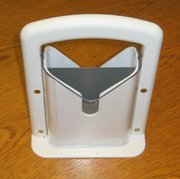Bagel
|
|
Bagel.jpg
The bagel (or sometimes beigel, in Poland also bajgiel, bajgel, precel, obwarzanek) is a food traditionally made of yeasted wheat dough in the form of a roughly hand-sized ring which is boiled and then baked. The result is a dense, doughy interior with a browned and sometimes crisp exterior. Fresh bagels can become stale very quickly, sometimes hard and inedible when just one day old.
A related bread product is a bialy.
Bagels should not be confused with doughnuts (donuts).
| Contents |
The bagel's history
The bagel originated in Central Europe, probably in Poland. A 1610 document from Krakow mentions "beygls" given as a gift to women in childbirth. This is often cited as the earliest known reference to the bagel, but the document is not clear what a "beygl" is; it may be what is now known as a bagel, it may be something related to the word for stirrup "beugal", or something else the meaning of which is lost to history.
An often repeated story says that the bagel originated in 1683, when a Jewish baker from Vienna (whose name seems never to be mentioned) created them as a gift to King Jan Sobieski of Poland to commemorate the King's victory over the Turks that year. The baked good was fashioned in the form of a stirrup to commemorate the victorious cavalry charge. That the name bagel originated from "beugal" (stirrup) is considered plausible by many both from the similarities of the word and due to the fact that traditional handmade bagels are not perfectly circular but rather slightly stirrup shaped. More prosaically, the name may simply originate from the Yiddish word "bugel" or the German word "bugel", meaning a round loaf of bread (see Gugelhupf for a German cake with a similar ring shape).
Immigrants in the 1880s brought the bagel to New York City, where it continues to flourish. Until the 1920s it was rare in other parts of the United States other than a few cities with large Eastern European Jewish communities. The bagel came into much more general use throughout North America in the last quarter of the 20th century. Specialized devices have even been invented to allow for easy slicing of bagels without "squishing" them (a perceived "danger" when using a knife and hand).
Bagel types
The two most prominent styles of bagel in North America are the Montreal bagel and the New York bagel. The Montreal bagel contains malt and egg and no salt; it is boiled in honey-sweetened water before baking in a wood oven; and it is predominantly either of the noir (poppyseed) or blanc (sesame seed) variety. The New York bagel contains salt and malt, is available in a wider variety of flavors, and is also boiled prior to baking in a standard oven. The resulting New York bagel is puffy with a noticeable crust, while the Montreal bagel is more dense and consistent throughout.
In addition to the plain bagel, there are variants with seasoning on the outside, including sesame, garlic, poppy seed, onion, rye and the "everything" bagel, a mixture of the forementioned. Other versions which change the dough recipe include cinnamon, raisin, pumpernickel, egg and sourdough. (In New York City, a green bagel, made with green food coloring, is created for St. Patrick's Day.)
In the late 20th century, many variations on the bagel flourished, including those made with different types of doughs, and with new non-traditional foods and seasonings added to the dough.
In areas where fresh bagels are not available at a bakery, they may sometimes be purchased frozen in a supermarket.
Bagels can also be made into Bagel Pizzas.
A new popular treat at local bagel stores are "Flagels": these are flat bagels of various toppings which do not have to be scooped out before adding a filling.
Bagel chips are a snack food variant on the bagel.
The bagel around the world
In Russia, the bublik has become so mainstream that most Russians aren't aware that it was originally a Jewish bread.
The Uighurs of Xinjiang (East Turkestan), China enjoy a form of bagel known as nang or girde nan bread (Allen, March 1996, p. 36-37). It is uncertain if the Uighur version of the bagel was developed independently of Europe or was the actual origin of the bagels that appeared in Central Europe.
Bagel sandwiches
The bagel sandwich, where a sliced bagel substitutes for the two slices of bread, has become common nowadays, although the bagel sandwich with cream cheese, lox, tomato and onion had already been a tradition among Jews for some time.
Another interesting and popular bagel dish is the pizza bagel. The bagel is sliced, topped with tomato sauce and cheese and then toasted or re-baked. It is an ideal toaster oven food.
Sliced bagels are often toasted.
References
- Allen, Thomas B. (March 1996). Xinjiang. National Geographic Magazine, p. 36-37.

